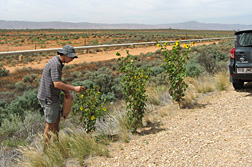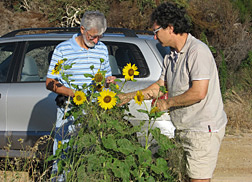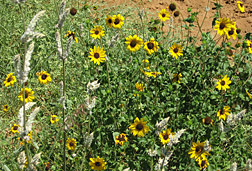Help From Down Under
Could Fortify U.S. Sunflowers
Improved disease resistance could be in store for tomorrow’s sunflower varieties, thanks to plants that ARS scientists collected in Australia and are evaluating in greenhouse trials in Fargo, North Dakota.
ARS plant pathologist Thomas Gulya and ARS botanist Gerald Seiler collected seeds of wild sunflowers while in Australia from February 17 to March 14, 2007. The ARS Plant Exploration Office funded their trip. Assisted by their Australian hosts, Gulya and Seiler traveled to every corner of Australia to make 59 collections of Helianthus annuus and H. debilis sunflowers—marking the first time the ARS researchers collected these wild species outside the plants’ native United States.
Gulya and Seiler say their ultimate goal is to find new genes that can be incorporated into American sunflower hybrids to make them more resistant to fungi that cause diseases such as downy mildew, rust, and Sclerotinia stalk rot. Each year, outbreaks of stalk rot and other forms of Sclerotinia disease cost about $252 million annually in losses to U.S. sunflower, canola, soybean, and other susceptible crops.
In Australia, rust is the bigger menace. There, mild to subtropical climates in areas where sunflowers grow allow the rust fungus, Puccinia helianthi, to skip its winter survival phase and evolve more rapidly via sexual recombination.
The upshot is “a great diversity of rust races in Australia—far greater than those observed in the United States,” notes Gulya, who, along with Seiler, is in the Sunflower Research Unit, which is part of ARS’s Red River Valley Agricultural Research Center in Fargo. Their hope is that rust’s nearly year-round presence has prompted a kind of sunflower survival of the fittest, whereby genes from the hardiest Aussie plants could be used to fortify the defenses of their U.S. brethren.
In fall 2007, “We began greenhouse trials of the 59 wild Australian sunflower populations we collected to evaluate their resistance to downy mildew, which doesn’t currently exist in Australia, and to rust, which is severe there,” says Gulya. “We’ll also compare them with some North American wild sunflower populations for resistance to Sclerotinia stalk rot. Of the three diseases, it is by far the most significant threat to the U.S. crop, so finding new sources of even partial resistance would be a great accomplishment.”
|
|
Seiler will analyze the Aussie plants’ seed oil content and fatty acid composition. Loren Rieseberg, a University of British Columbia collaborator, will compare their genetic profiles to those of American wild sunflowers. This could reveal whether the Australian sunflowers have undergone significant genetic changes since arriving in the Land Down Under more than 100 years ago from America.
“Though we were mainly interested in disease resistance, we collected across a broad geographic and climatic range to capture as much genetic diversity as possible,” says Guyla. Indeed, their expedition took them on a 6,200-mile journey through West and South Australia, New South Wales, Victoria, and Queensland.
|
|
Plant pathologist Gary Kong and technicians Jeff Mitchell and Sue Thompson, from the Department of Primary Industries and Fisheries in Queensland, helped organize the trip itinerary and accompanied the ARS researchers. The Australians also made an additional collection trip to areas near their Toowoomba, Queensland, location.
On average, the team gathered 6,000 seeds per collection, which included wild populations from yards, hedgerows, vacant lots, sandy beaches, and many municipal garbage dumps, which were among the most productive sites for collecting seed, says Gulya.
The ARS researchers arrived stateside 3 months before their sunflower bounty, however. That’s because the seeds first had to be fumigated and inspected.
Even if new genes for disease resistance aren’t found, the Australian plants’ seed will be made available to researchers in both the United States and abroad. After testing is complete, the ARS team plans on storing the seed in the Helianthus germplasm collection at ARS’s Plant Introduction Station in Ames, Iowa. “That way,” says Gulya, “future researchers who might have different research objectives can use this germplasm to find traits we’re currently not interested in, or are unaware of, at the moment.”—By Jan Suszkiw, Agricultural Research Service Information Staff.
This research is part of Plant Genetic Resources, Genomics, and Genetic Improvement, an ARS national program (#301) described on the World Wide Web at www.nps.ars.usda.gov.
Thomas J. Gulya and Gerald J. Seiler are in the USDA-ARS Sunflower Research Unit, Red River Valley Agricultural Research Center, 1307 N. 18th St., Fargo, ND 58105; phone (701) 239-1316 [Gulya], (701) 239-1380 [Seiler], fax (701) 239-1346.
"Help From Down Under Could Fortify U.S. Sunflowers" was published in the May/June 2008 issue of Agricultural Research magazine.











